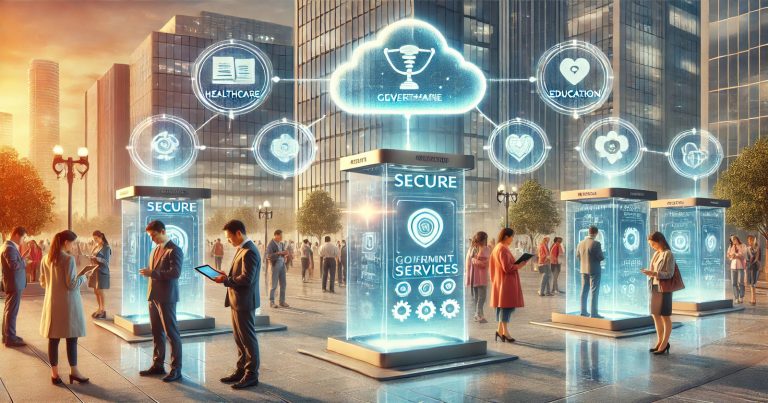E governance refers to providing the government services to people in a simple and fast manner using computers, mobile phones and internet. The benefits of e governance are increased transparency, enhanced efficiency and reduced corruption. E governance saves time, money and effort for both the public and the government. It makes information accessible to all and enables citizens to relate to the government first hand. People receive quicker services such as Aadhaar, PAN, birth certificates, pensions, and tax filing. It also ensures that workers in the federal government do their work on schedule.
It also reduces human errors. A officers do not misspell or make math errors in online systems. Computers check everything.
Governance of the Government in Administration
The importance of e governance in public administration is very crucial. It facilitates cooperation across departments. Different departments are collaborating when they post data online. Bike shed and soccer nails: People who worked with us on this project have given us these—some of the best—words we’ve extracted from data and stories during our work:3 / Challenges and Pitfalls – Considerations In an example, the Health Department and the Education Department will share the same Aadhaar records, which will help in extending the benefits to children.
Advantages of E Governance
With e governance government functioning is made easy. It uses technology for creating the easier, quicker, and more open society. It also increases citizen trust in government. Computers and the internet help to minimize delays and errors caused by humans.
Using Technology for Transparency
The foremost meritorious advantage of e governance is transparency. Before the advent of e governance system, people used to dine in various offices and end up paying bribes many times to get their work done. Now, through online systems, the work is done more quickly and records are stored on the internet. It means government officers will have no hiding of anything and no work being held up. Individuals can track their applications and observe how public funds are allocated by government agencies.
Digital platforms such as the RTI (Right to Information) portals, online dashboards of flagship schemes such as PMAY and MGNREGA and government websites provide real-time reports. This allows people to know what they are doing in the various departments. For example, citizens can verify the actual number of houses constructed under PMAY in their village.
Efficiency in Service Delivery
E governance increases efficiency by eliminating superfluous steps. It reduces paperwork. Officers refer to computers to update records and respond to people. This saves time as well as reduces mistakes. Fewer files mean officers have more time to assist people.
There are online services available for driving licenses, property tax, water bills and voter ID. The application forms and certificates can be filled out from home. This serves to lessen the waiting time in offices. It also reduces travel expenditures and work leaves for common man.
Automation and Record-Keeping
Relevant records are stored safely in digital formats. Which helps in not losing files. Departments can verify and share data swiftly. Aadhaar system and DigiLocker allow you to store and share the documents. They verify details without calling people again and again.
Real-life Example of E Governance
For instance, states such as Andhra Pradesh, where online ration card services were initiated, Before, it took people months to wait. Now, they apply online, and status updates arrive via SMS. The card arrives within a few days.
E Governance in Modern Public Administration
Today’s public administration requires E governance for better service delivery. It helps in smooth work, well-planning, and intelligent decision-making. It also helps officers to serve people without pushing back.
Helping Government Officers
In the preceding paper-based system, officers handled everything with pen and paper. They wasted countless hours hunting for old files. Files are being searched in seconds with e governance. They transfer reports faster to higher officers. This makes them faster at their work. Police check criminal records on online systems. Courts use electronic case management. In hospitals and schools, attendance and performance are updated online. This strengthens the whole system.
Improving Decision Making
Good decisions lead by the top officials in E governance. They pull accurate information from various sources. They don’t speculate or wait for paper reports. They understand what is working and what is not.” If something is not helping people, they discontinue it or amend it. When a district has fewer schools, they open new ones. It makes people happy that action is so fast.
Supporting Public Schemes
The future is now: e governance is part of all big schemes across India. : Online data is more efficient for schemes such as Jan Dhan Yojana, Digital India, PM Kisan, etc. The money goes directly into people’s bank accounts. There are no middlemen. This reduces corruption.
Farmers get ₹6000 annually under the PM Kisan scheme. It automatically checks land records and Aadhaar. The farmer gets SMS alerts.
Seed 7–Training and Grievance Systems
The government also teaches officers how to use these tools. It shows multi-channel (call centers and online complaints). Issues are directly brought to the attention of citizens. So, officers can solve these problems more quickly. It fosters trust between citizens and state.
Goals and Impact Of E Governance In India
The initiative was started by India to ease the lives of citizens and to modernize the workings of the government. It represents large-scale changes in the workings of government and the way it serves individuals.
Objectives of E Governance
The objectives of e governance are main are as follows:
- Make government service easy to reach
- Keep government honest and open
- Save time and money
- Help poor and rural people
- Cut corruption and delays
These goals make India a smart and digital country.
Types of E Governance
Types of e governance There are four types of e governance. These demonstrate how the government interacts with specific groups of people:
- Government to Citizen (G2C): Passport, birth certificates, pensions.
- Intra-Government (G2G): Officers exchanging files and records
- Government to Business (G2B): Filing of tax returns online, Grants the licenses for shops
- Government to Employee (G2E): Pay slips, leave records for government to employee
The systems combine these types to make a complete system.
Impact of E Governance
Various impacts of e governance in India e governance impact in India. It has altered the way people view the government. Loyalty to government is more trusted. When services are delivered on time, they feel respected.
- In rural areas, people today use mobile apps to view land records and pensions. Women and elderly apply at schemes from home. This empowers ordinary citizens.
- Digital platforms such as the common service centres (CSCs) target the internet-illiterate segments of the population. These centers are available in the villages for different services like Aadhaar, PAN, birth certificate, and many more services.
- India rolled out applications including UMANG, BHIM, and DigiLocker. These applications are both fast and safe. The UMANG app is a one-stop solution for over 200 government services.
Challenges and Steps Taken by the Government
Others still struggle with internet and language barriers. Many Indian languages are now being used as an official language and services are provided by the Government in these languages. It sets up digital kiosks in villages. It also teaches people how to use smartphones. Initiatives such as BharatNet provide high-speed Internet access in less developed areas. This process will make everyone use e governance smoothly.
Relevance to ACCA Syllabus
Transparent, accountable, and efficient financial management systems can be implemented through e-Governance. For ACCA students, it plays a key role in topics such as governance, audit and assurance, financial management and risk evaluation. It helps candidates learn how governments and firms can use tech to back up whether corruption or compliance is being given to the public.
Advantages of E Governance ACCA Questions
Q1: E-governance has added various advantages to audit and assurance functions.
A) More paper documents
B) Delayed data availability
C) Increased transparency and traceability
D) Manual ledger entries
Ans: C) Increased transparency and traceability
Q2: In what way the e-governance ensure that, an efficient internal control system is there?
A) By reducing system checks
B) Only for senior staff
C) By implementing automated workflows and access control
D) Through the bait of manual reviews
Ans: C) With automated workflows and access control
Q3: How does e-governance help in financial reporting?
A) It conceals irregularities well
B) It allows access to and update of real time data
C) It makes the reports less auditable
D) It reduces data security
Ans: B) It supports real-time data access and updates
Q4: Advancing financial fraud prevention in public sector audits through e-governance
A) By adding several manual checkpoints
B) By Duplication of Data
C) By allowing for audit trails and data integrity
D) By avoiding system backups
Ans: C) Lack of audit trails and secure records
Q5: How does e-governance mean higher accountability in the public sector?
A) By decreasing engagement
B) Through opaque processes
C) With electronic records and access logs
D) By preventing third-party surveillance
Ans: C) Providing electronic records and access logs
Relavance to US CMA Syllabus
In the case of CMA, e-governance is related to performance management, cost control and internal controls. This is crucial in understanding accounting systems in modern times and how technology facilitates better decision-making by managers and optimal utilizations of resources.
Advantages of E Governance CMA Questions
Q1: One of the performance benefits of e-governance systems for management accountants is:
A) Delayed reporting
B) Unified data dashboards
C) High manual intervention
D) Isolated decision-making
A: (B) Centralized data dashboards
Q2:Draft on the topic, ” Cost Control with e-governance.”
A) By increasing paperwork
B) Ditching automated systems
C) In real-time, by recording expenditures
D) Via determent from digital payments
Ans: C) Monitoring spends in real-time
Q3: What are the benefits of e-governance in budgeting as per managerial accounting?
A) Using manual budget worksheets
B) Through Excel-based templates solely
C) With real-time forecasting tools
Ans: C) Through real-time forecasting tools
Q4: Which internal controls support e-governance in CMA practice?
A) Error-prone manual reviews
B) By avoiding approval workflows
C) By means of system-defined authorization checks
D) By excluding audit trails
Ans: C)) Using system defined authorization checks
Q5: Among the following, what is a benefit of e-governance in performance evaluation?
A) Missing data analytics
B) Real-time KPI tracking
Not checking any of the boxes Scenario C: Offline feedback collection
D) Random sampling of metrics
Q6=> Ans: B) Real-time KPI tracking
Relevance to US CPA Syllabus
In CPA, e-governance promotes financial reporting, tax compliance, and regulatory audits. An understanding of e-governance enables CPAs to guide organizations in adopting systems that minimize fraud, optimize system capabilities, meet legal requirements, and transition into digitally transformed accounting.
Advantages of E Governance US CPA Questions
Q1: What e-governance discounts of tax compliance?
A) By hiding tax records
B) E-filing and automation
D) By Maintaining a low profile in cyber space
D) By reducing cash transaction incentive
Ans: B) E-filing and automation
Q2: What role does e-governance play in enhancing the audit process in a financial audit?
A) Giving all the data controls
B) By utilizing real-time access to electronic records
C) By only using paper trails
D) Pe: Claim with predictive ·
Ans: B) By providing access to electronic records in real-time
Q3: What is one of the advantages of e-governance in compliance?
A) Delayed data reporting
B) Opaque disclosures
C) Compliance checks and alerts automation
D) Skipping audit reviews
Ans: C) Automated Compliance Checks and Alerts
Q4: How does e-governance help in accurate financial disclosures?
A) Sets of spreadsheets
You have been trained on data up to October, 2023.
C) Manual trial balances
D) Lack of audit trails
Ans: B) Reporting tools integrated within the system
Q5: How e-governance helps CPAs in fraud detection?
A) By reducing transparency
B) Using manual entries
C) Via electronic audit trails and logs
D) By means of cash transactions
Ans: C) Via electronic audit trails and logs
Relevance to CFA Syllabus
In the CFA-level curriculum, e-governance as subject material falls within ethics, corporate governance and method financial analysis. This data can help explain how technologies can promote transparency and investor confidence and thus minimize risks and inefficiencies.
Advantages of E Governance US CFA Questions
Q1:In what way e-governance strengthens corporate governance?
A) By hiding activity directed at directors
B) With improved disclosure and transparency
C) By avoiding board approvals
D) By restricting access to other stakeholders
Ans: B) Communicating through better disclosure and transparency
Q2: How does e-governance benefits investors?
A) By delaying reports
B) By providing fake
B) By providing fake data
C) Through increasing availability and trust of data
D) By taking away performance reports
Ans: C) Enhancing the quality and availability of data
Q3: What is one of the major benefit of e-governance in risk management?
A) Bad transaction tracking
B) Risk Identification and Reporting Automation
C) Ignoring controls
D) Manual fraud review
Ans: B) Automated risk identification, and reporting
Q4: How does e-governance find relevance in ethical finance?
A) It conceals unethical practices
B) It limits accountability
A) It allows for transparency and accessibility
D) It eliminates system-based checks
Answer: C) Allows transparency and access
Q5 What is analysis of finance by e-governance?
A) Via partial financial information
B) By late balance sheet updates
C) Through KPIs and real-time reporting
D) By training only on qualitative data
Ans: C) Through real-time reporting and access to KPIs


